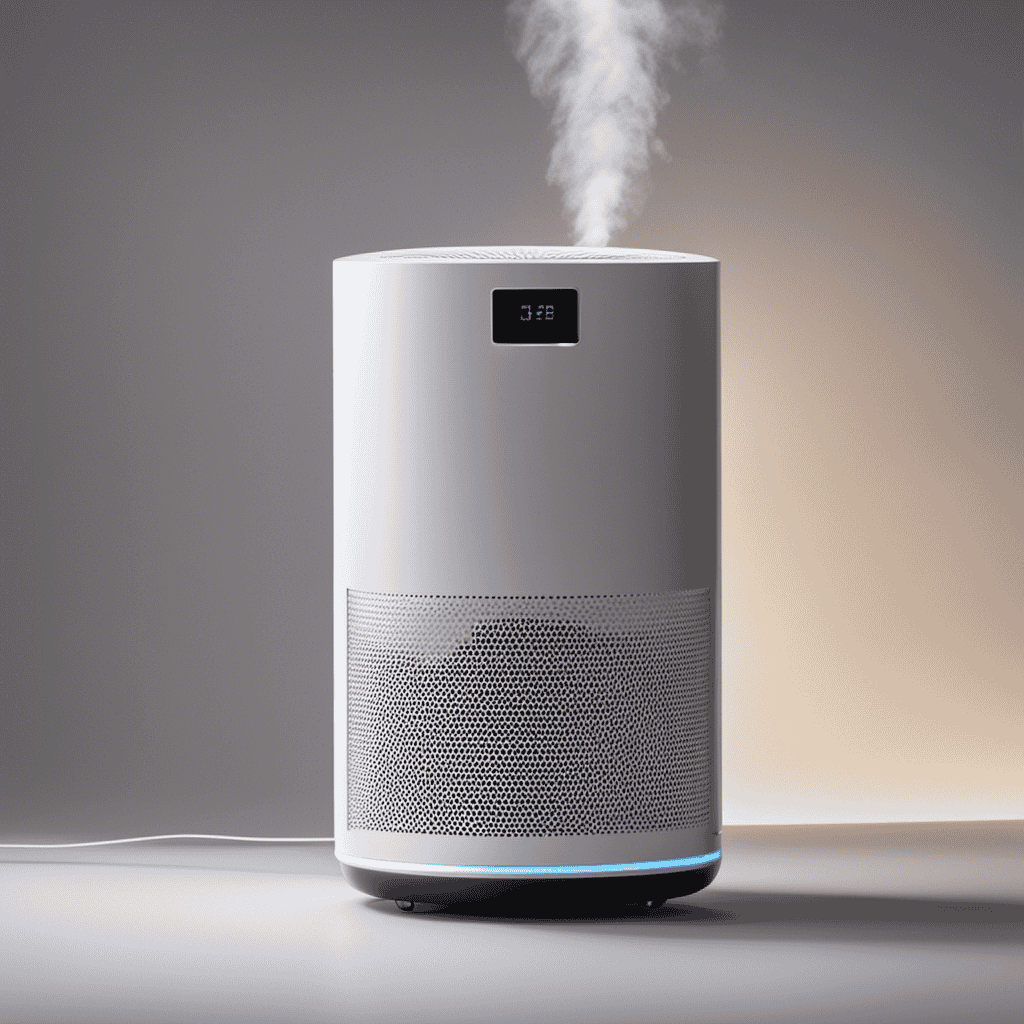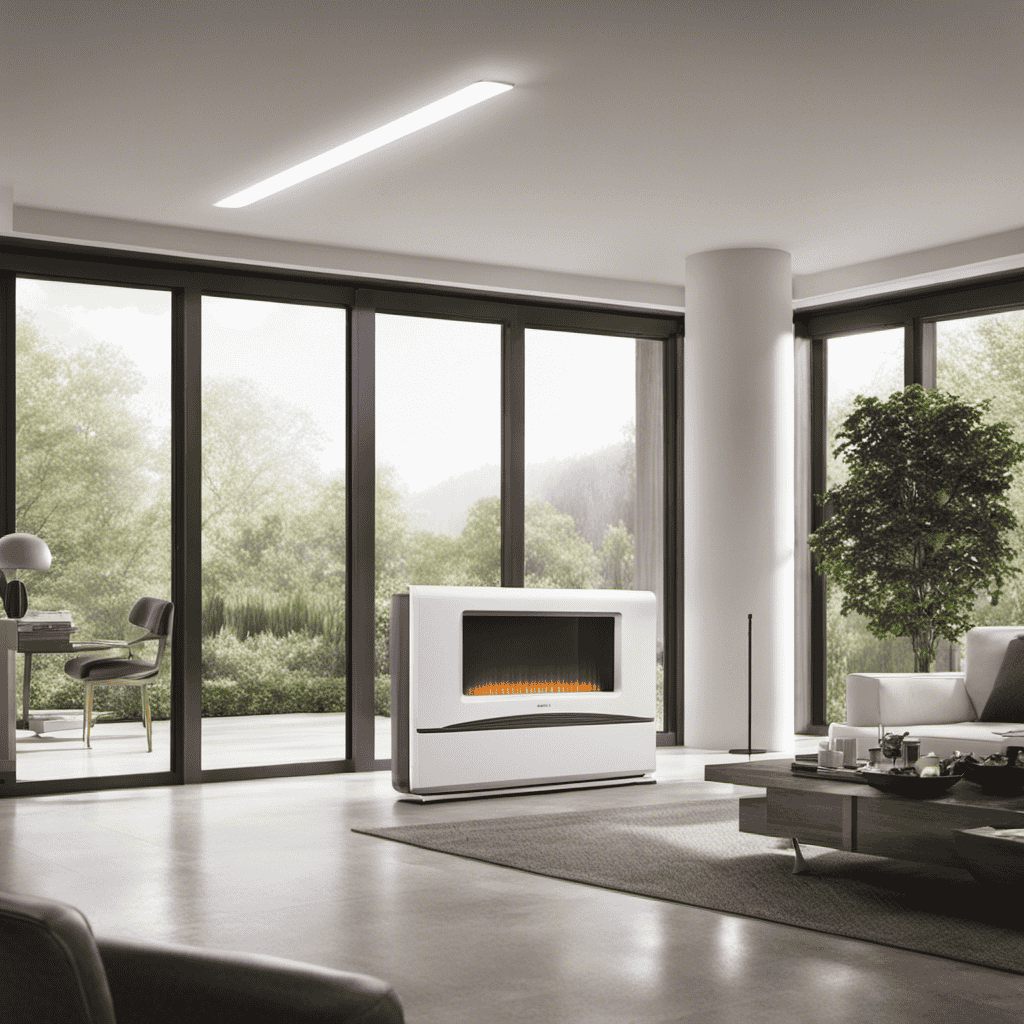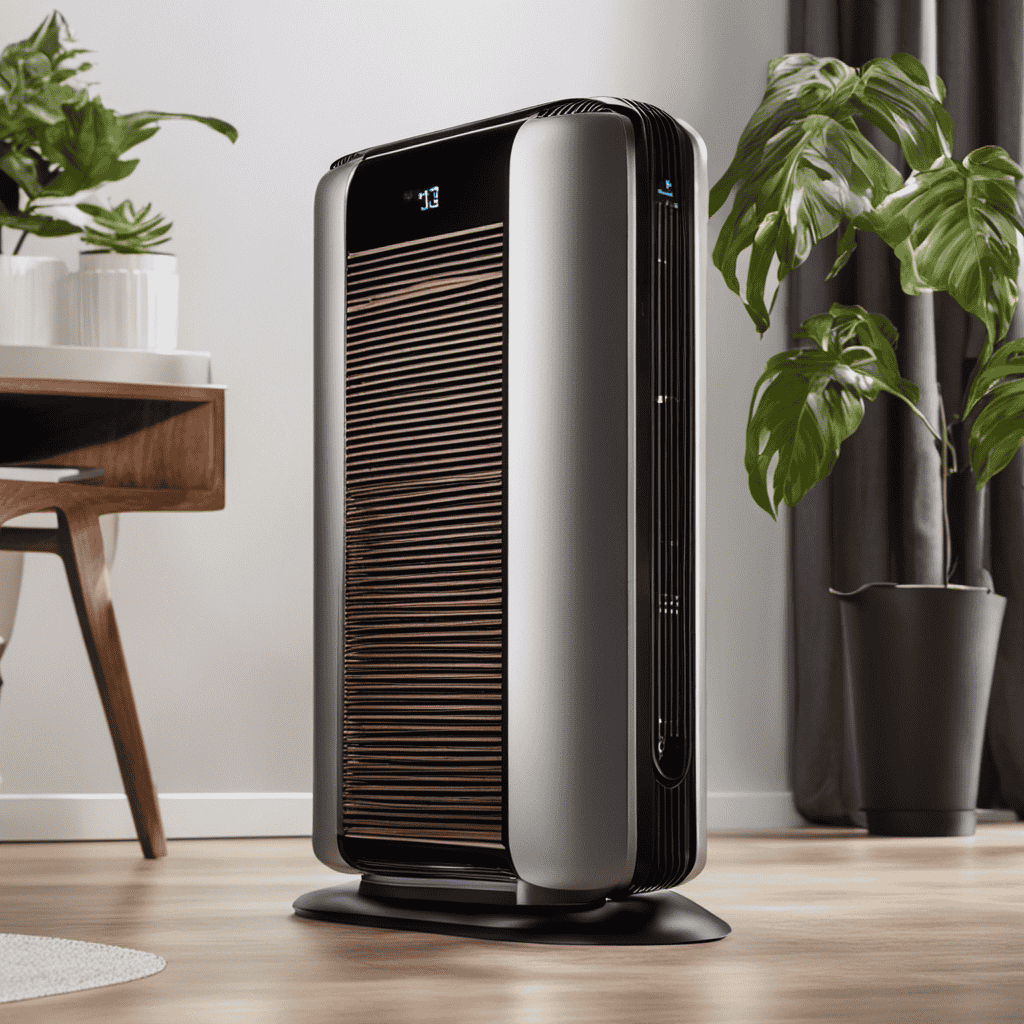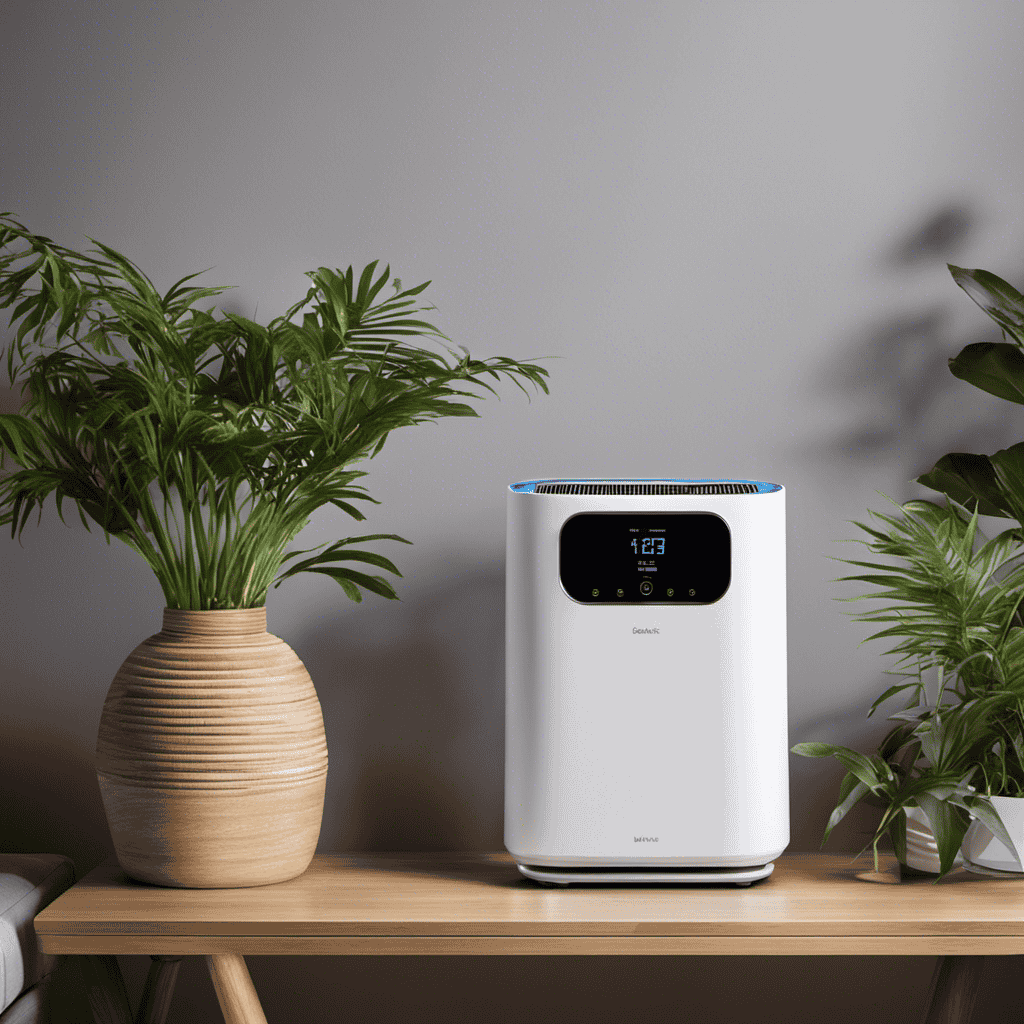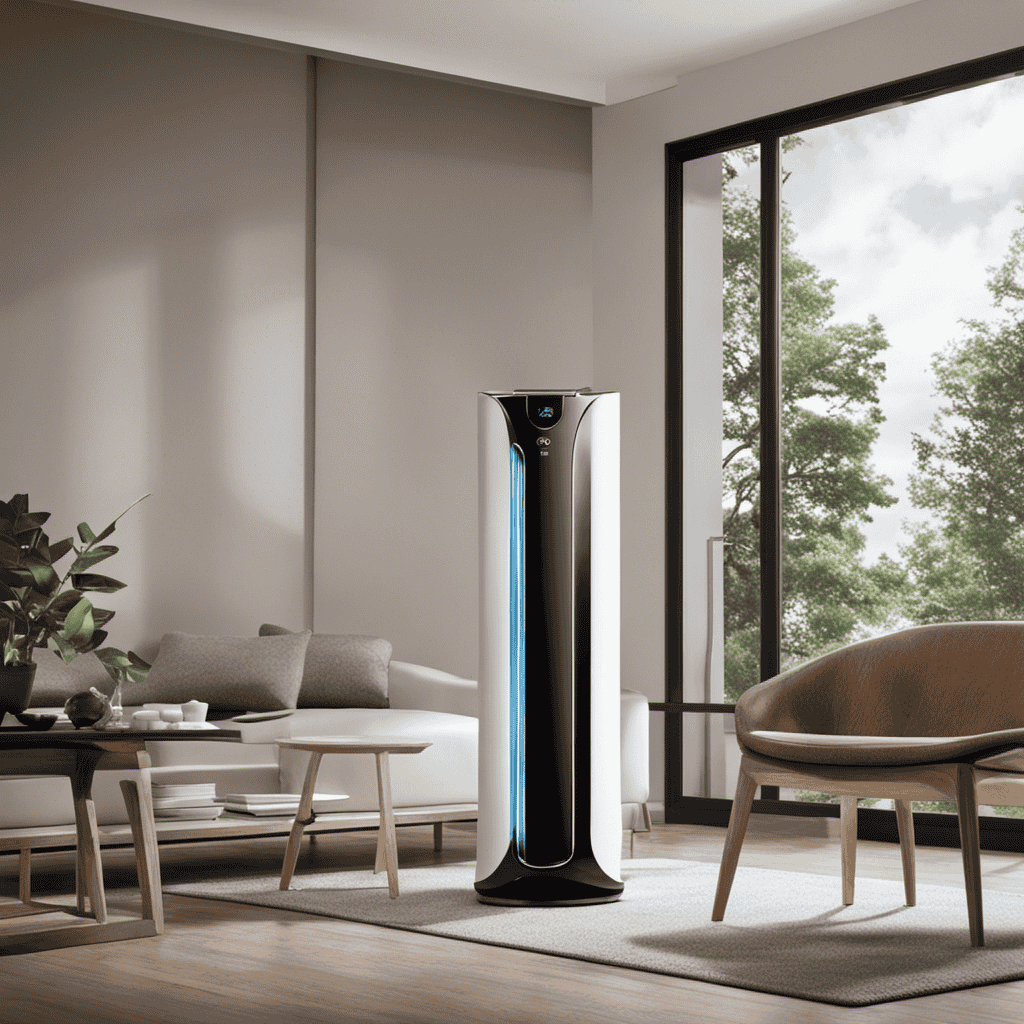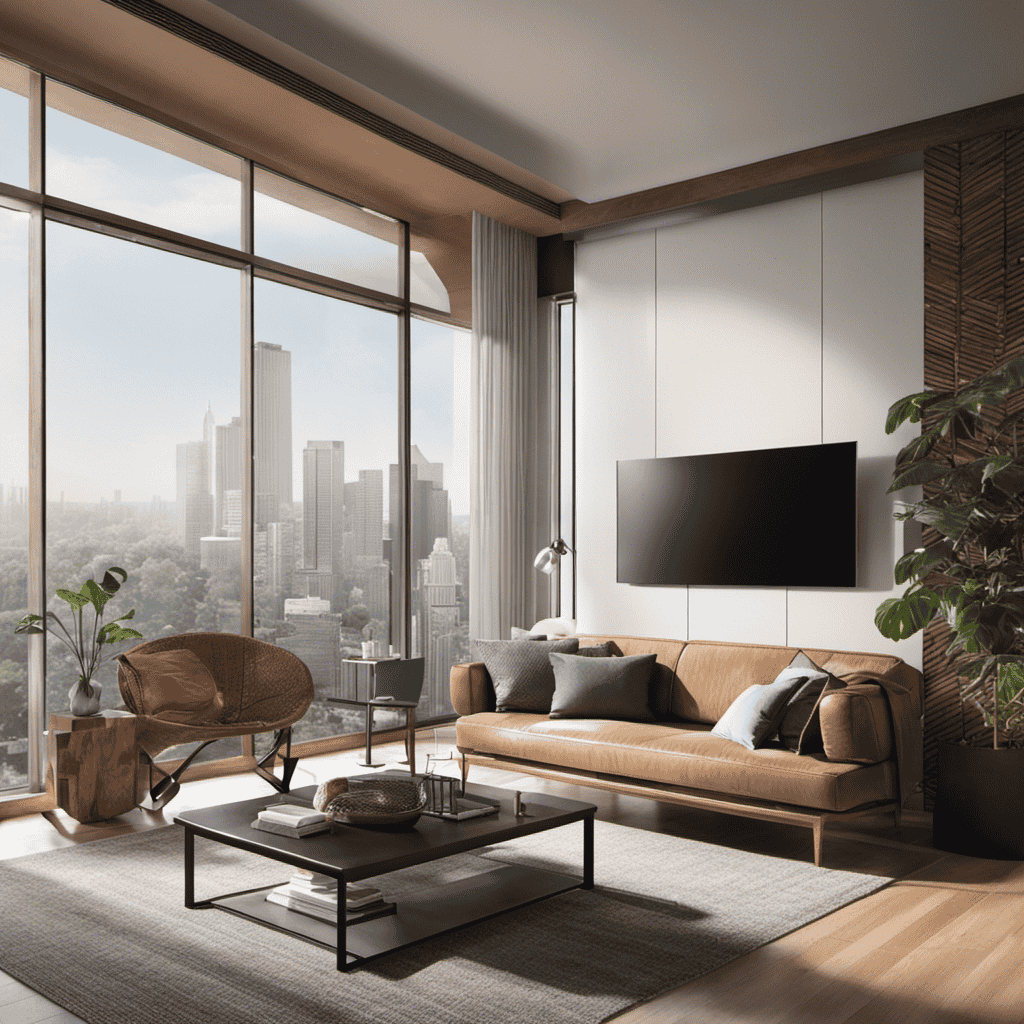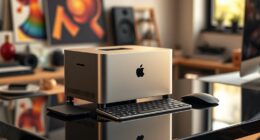I understand your curiosity about how an electronic air purifier functions. Allow me to explain it to you.
Electronic air purifiers use advanced technology to clean the air in your home or office. They are equipped with filters and key components that effectively remove airborne contaminants. One crucial element is ionization, which helps to neutralize pollutants.
However, it’s important to understand that electronic air purifiers may not eliminate all types of contaminants. In this article, we’ll explore the ins and outs of electronic air purifiers and help you choose the right one for your needs.
Key Takeaways
- Electronic air purifiers use ionization to neutralize pollutants and make them easier to clean.
- Components like filters, ionizers, and sensors may require periodic replacement or cleaning for optimal performance.
- Modern electronic air purifiers utilize technologies like HEPA filters, activated carbon filters, and UV-C light.
- Filters trap and remove various airborne particles and pollutants, preventing them from circulating back into the air.
How Does an Electronic Air Purifier Clean the Air
To understand how an electronic air purifier cleans the air, you need to know about its internal components and processes.
One important component is ionization technology, which helps to remove airborne particles from the air. This technology works by releasing negatively charged ions into the air, which attach to positively charged particles like dust, pollen, and pet dander. Once the particles are charged, they become heavier and are attracted to surfaces like walls or furniture, where they can be easily cleaned or vacuumed.
Another key component in the air purifier is UV C light. This type of ultraviolet light is effective in killing bacteria, viruses, and mold spores by damaging their DNA.
Understanding the Technology Behind Electronic Air Purifiers
Understanding how electronic air purifiers function can help you make an informed decision about whether or not to use one in your home. Electronic air purifiers utilize advanced technology to improve indoor air quality. Here are two key subtopics to consider:
-
Air Purifier Maintenance
-
Regular cleaning of the air purifier is essential to ensure its optimal performance.
-
Components such as filters, ionizers, and sensors may require periodic replacement or cleaning.
-
Air Purifier Technology Advancements
-
Modern electronic air purifiers employ cutting-edge technologies like HEPA filters, activated carbon filters, and UV-C light.
-
Some models also incorporate smart features, such as air quality sensors and Wi-Fi connectivity, allowing remote control and monitoring.
By understanding these advancements and the need for maintenance, you can choose the most suitable electronic air purifier for your home.
Now let’s delve into the role of filters in electronic air purifiers.
The Role of Filters in Electronic Air Purifiers
Regularly cleaning and replacing the filters in my electronic air purifier is crucial for maintaining its effectiveness. The filters play a vital role in trapping and removing various airborne particles and pollutants from the air.
One type of filter commonly used in electronic air purifiers is electrostatic filtration. This technology uses an electric charge to attract and capture particles, such as dust, pollen, and pet dander. The electrostatically charged filter efficiently captures these particles, preventing them from circulating back into the air.
Another important filter to consider is one that utilizes activated carbon. Activated carbon filters are effective at removing odors, gases, and volatile organic compounds (VOCs) from the air. This is achieved through a process called adsorption, where the carbon particles chemically bond with the molecules of the pollutants.
Key Components of an Electronic Air Purifier
When it comes to the air purification process, understanding the essential filtration elements is crucial.
The air purification process involves removing contaminants and pollutants from the air to improve its quality.
Essential filtration elements such as HEPA filters, activated carbon filters, and electrostatic filters play a vital role in capturing particles, odors, and allergens, ensuring that the air we breathe is clean and healthy.
Air Purification Process
To effectively purify the air in your home, you’ll want to know how an electronic air purifier works. Here’s a breakdown of the air purification process:
-
Pre-filtration:
-
The air is drawn into the purifier through an intake vent.
-
Larger particles such as dust, pet hair, and pollen are captured by a pre-filter.
-
HEPA filtration:
-
The air then passes through a High-Efficiency Particulate Air (HEPA) filter.
-
This filter traps tiny particles, including bacteria, mold spores, and allergens.
-
Activated carbon filtration:
-
After passing through the HEPA filter, the air moves through an activated carbon filter.
-
This filter removes odors, volatile organic compounds (VOCs), and chemicals.
-
Ionization:
-
Some electronic air purifiers use ionization to charge particles in the air.
-
Charged particles are attracted to oppositely charged plates, effectively removing them from the air.
Using an electronic air purifier provides numerous benefits, including:
- Improved indoor air quality by removing pollutants and allergens.
- Reduction of asthma and allergy symptoms.
- Elimination of unpleasant odors.
- Protection against harmful substances like VOCs.
- Increased overall health and well-being for you and your family.
Essential Filtration Elements
The essential filtration elements in an electronic air purifier include a pre-filter, a HEPA filter, an activated carbon filter, and ionization. These components work together to remove various pollutants from the air, ensuring improved air quality. Let’s take a closer look at each filtration element and its role in the air purification process.
| Filtration Element | Function |
|---|---|
| Pre-filter | Captures larger particles such as dust, pet dander, and pollen, improving the overall efficiency of the subsequent filters. |
| HEPA filter | Removes 99.97% of particles as small as 0.3 microns, including fine dust, mold spores, and allergens, significantly enhancing air quality. |
| Activated carbon filter | Absorbs gases, odors, and volatile organic compounds (VOCs), ensuring fresher and cleaner air. |
| Ionization | Releases negatively charged ions that attach to positively charged particles, causing them to clump together and fall out of the air, further improving filtration efficiency. |
The Importance of Ionization in Electronic Air Purifiers
Ionization is a key factor in how electronic air purifiers effectively clean the air. Through the process of ionization, these devices release charged particles, known as ions, into the air. These ions attach themselves to airborne particles, such as dust, pollen, and pet dander, causing them to become charged as well. This process has several benefits, including improved filtration, odor reduction, and bacterial and viral control.
Improved filtration: The charged particles are attracted to oppositely charged plates within the air purifier, effectively trapping them and preventing them from recirculating in the air.
Odor reduction: Ionization can also help eliminate unpleasant odors by neutralizing odor-causing particles in the air.
Bacterial and viral control: Some studies suggest that ionization can help reduce the spread of certain viruses and bacteria by neutralizing their airborne particles.
Understanding the importance of ionization in air purifiers sets the stage for exploring how ultraviolet (UV) light works in these devices.
How Does Ultraviolet (UV) Light Work in Electronic Air Purifiers
When it comes to electronic air purifiers, one of the key processes in eliminating airborne germs is the use of ultraviolet (UV) light. UV light works by damaging the DNA and RNA of microorganisms, such as bacteria and viruses, rendering them unable to reproduce and causing their demise.
This technology offers numerous benefits, including the ability to effectively eliminate harmful germs, improve indoor air quality, and reduce the risk of infection and illness.
UV Light Purification Process
To effectively purify the air in your home, you’ll want to understand how UV light works in the purification process. UV light is a powerful tool in air purification, particularly when it comes to sterilization. Here’s how the UV light purification process works:
-
UV light sterilization:
- UV light is emitted from the air purifier.
- As air passes through the purifier, microorganisms such as bacteria and viruses are exposed to the UV light.
- The UV light damages the DNA or RNA of these microorganisms, rendering them unable to reproduce and causing their death.
- This process effectively sterilizes the air, removing harmful pathogens and ensuring cleaner, safer indoor air quality.
-
Effectiveness of UV light purification:
- Studies have shown that UV light can effectively eliminate up to 99.9% of airborne microorganisms.
- It is particularly effective against bacteria, viruses, and mold spores.
- UV light purification is a chemical-free and environmentally friendly method of air purification.
- However, it’s important to note that UV light purification should be used in conjunction with other air filtration methods for optimal results.
Airborne Germ Elimination
In order to effectively eliminate airborne germs, you’ll want to consider using UV light purification in conjunction with other air filtration methods.
UV light purification is a highly effective technique for airborne virus protection and indoor air quality improvement. UV light works by emitting short-wavelength ultraviolet radiation, which can penetrate the outer structure of microorganisms and disrupt their DNA, rendering them unable to reproduce.
When used in air purifiers, UV light can kill or deactivate a wide range of airborne pathogens, including bacteria, viruses, and mold spores. However, it is important to note that UV light purification should be used in combination with other air filtration methods, such as HEPA filters, to ensure comprehensive removal of airborne germs.
Benefits of UV Technology
Moving on from the previous subtopic on airborne germ elimination, let’s now explore the benefits of UV technology in electronic air purifiers.
UV technology, also known as ultraviolet germicidal irradiation (UVGI), utilizes ultraviolet light to kill or inactivate microorganisms. Here are some key benefits of UV technology:
- Effective germicidal action: UV light has been proven to destroy a wide range of microorganisms, including bacteria, viruses, and mold spores.
- Chemical-free purification: Unlike some other air purification methods, UV technology does not rely on the use of chemicals, making it a safe and environmentally friendly option.
To understand why UV technology is so effective, it’s important to consider the importance of ionization. When UV light interacts with air molecules, it generates ions that have the ability to neutralize harmful particles, such as bacteria and viruses. This ionization process enhances the overall purification process, ensuring cleaner and healthier air.
Now, let’s delve into the subsequent section about electrostatic precipitation, another effective air purification method.
Electrostatic Precipitation: An Effective Air Purification Method
Electrostatic precipitation is an effective method for air purification.
This process involves the use of an electrostatic filter and air ionization to remove airborne contaminants.
The electrostatic filter works by charging particles in the air as they pass through, causing them to adhere to the filter plates.
This effectively traps the pollutants and prevents them from being released back into the air.
Air ionization, on the other hand, involves the generation of negative ions that attach themselves to positively charged particles, causing them to become heavy and fall out of the air.
Together, these two methods work to significantly reduce the levels of pollutants in the air.
However, it is important to note that while electronic air purifiers can remove many types of airborne contaminants, they may not be able to eliminate all types completely.
Can Electronic Air Purifiers Remove All Types of Airborne Contaminants
I’ve conducted research on electronic air purifiers and their ability to remove various types of airborne contaminants.
In my findings, I discovered that these devices are particularly effective against volatile organic compounds (VOCs). VOCs are commonly found in household products and can cause respiratory issues.
Additionally, electronic air purifiers have proven to be highly efficient in removing pet dander. Pet dander is a common allergen that can trigger allergic reactions in individuals.
Lastly, these devices have been found to effectively eliminate mold spores. Mold spores can lead to respiratory problems and other health issues if left unaddressed.
Effective Against Vocs
An electronic air purifier can be effective against VOCs, helping to improve indoor air quality. VOCs, or volatile organic compounds, are chemicals that can be released into the air from various sources such as cleaning products, paints, and furniture.
Here are two benefits of using electronic air purifiers to combat VOCs:
-
Filtration: Electronic air purifiers use filters to trap and remove airborne particles, including VOCs. The filters are designed to capture even the smallest particles, ensuring that VOCs are effectively removed from the air.
-
Activated Carbon: Many electronic air purifiers are equipped with activated carbon filters. These filters are highly effective in adsorbing VOCs, as the carbon has a large surface area that can attract and trap the chemicals. This helps to further improve indoor air quality by reducing the presence of harmful VOCs.
Overall, electronic air purifiers provide a reliable and efficient solution for combating VOCs and enhancing indoor air quality.
Removes Pet Dander
In addition to being effective against VOCs, electronic air purifiers are also highly efficient in removing pet dander from the air. Pet dander consists of tiny particles of skin, saliva, and urine that are shed by animals and can trigger allergic reactions in sensitive individuals.
Air purifiers with HEPA filters are particularly effective in capturing and trapping these microscopic particles, preventing them from circulating in the air. The powerful fans in electronic air purifiers help to draw in the air and pass it through the filtration system, effectively removing pet dander and providing much-needed allergy relief.
Now, let’s explore how these air purifiers eliminate mold spores.
Eliminates Mold Spores?
By effectively capturing and trapping mold spores, electronic air purifiers provide a solution for individuals seeking relief from mold allergies. These devices utilize advanced filtration technology to eliminate allergens and prevent respiratory issues caused by mold exposure.
Here’s how electronic air purifiers work to eliminate mold spores:
-
High-Efficiency Particulate Air (HEPA) Filters: These filters are designed to capture even the smallest particles, including mold spores. They work by forcing air through a fine mesh that traps the spores and prevents them from circulating in the air.
-
Ultraviolet Germicidal Irradiation (UVGI): Some electronic air purifiers use UVGI technology to kill mold spores. UV light is emitted, which damages the DNA of the spores, rendering them unable to reproduce or cause harm.
The Pros and Cons of Using an Electronic Air Purifier
Did you know that using an electronic air purifier can have both advantages and disadvantages?
Electronic air purifiers, also known as ionizers, are devices that use electrically charged particles to remove airborne pollutants from the air.
One of the main advantages of using an electronic air purifier is its ability to remove small particles, such as pollen, dust, and pet dander, from the air. This can be particularly beneficial for individuals with allergies or asthma.
Additionally, electronic air purifiers do not require the use of filters, making them more cost-effective in the long run.
However, there are also some disadvantages to consider. Electronic air purifiers do not remove odors or gases from the air, and they can produce ozone, which can be harmful in high concentrations.
It is important to weigh the pros and cons before deciding if an electronic air purifier is the right choice for your needs.
Maintaining and Cleaning Electronic Air Purifiers
To keep your electronic air purifier running efficiently, make sure to regularly clean the filters and remove any accumulated dust or debris. Neglecting maintenance can lead to decreased performance and potentially even damage to the unit. Here are some important steps to maintain and troubleshoot your electronic air purifier:
-
Cleaning the filters:
-
Turn off the air purifier and unplug it from the power source.
-
Remove the filters according to the manufacturer’s instructions.
-
Gently vacuum or rinse the filters to remove dust and dirt.
-
Allow the filters to completely dry before reinstalling them.
-
Removing accumulated dust and debris:
-
Use a soft, dry cloth to wipe the exterior of the air purifier.
-
Pay special attention to vents and openings where dust can accumulate.
-
Use a small brush or vacuum attachment to remove dust from the internal components.
Regularly maintaining your electronic air purifier will ensure that it continues to provide clean and fresh air for you and your family.
Choosing the Right Electronic Air Purifier for Your Needs
When choosing the right electronic air purifier for your needs, consider factors such as room size, filter type, and noise level.
Air purifiers are designed to remove common air pollutants, such as dust, pollen, pet dander, and smoke particles, from the air in your home or office.
To ensure optimal performance, regular air purifier maintenance is essential. This includes cleaning or replacing the filters, as well as keeping the unit free from dust and debris.
Different air purifiers use different types of filters, such as HEPA filters or activated carbon filters, to capture and trap these pollutants.
Additionally, the noise level of the air purifier is also an important consideration, especially if you plan to use it in a bedroom or office space where quiet operation is desired.
Frequently Asked Questions
Are Electronic Air Purifiers Safe to Use Around Children and Pets?
Electronic air purifiers are safe to use around children and pets. They effectively remove pet dander and other airborne pollutants, improving indoor air quality. However, it’s important to choose a purifier with appropriate filters and follow manufacturer’s instructions for optimal safety.
Can an Electronic Air Purifier Eliminate Odors From the Air?
Yes, an electronic air purifier can eliminate odors from the air. It is effective in removing smells like cigarette smoke and pet odors. The purification process involves capturing and neutralizing odor-causing particles.
How Often Should I Replace the Filters in an Electronic Air Purifier?
How often should I replace the filters in an electronic air purifier? To maintain optimal performance, the filters should be cleaned or replaced every 3-6 months. Regular maintenance ensures that the air purifier continues to effectively remove pollutants and improve indoor air quality.
Can an Electronic Air Purifier Help With Allergies?
An electronic air purifier can help with allergies by removing allergens from the air. Its effectiveness lies in its ability to capture and neutralize particles like pollen, dust, and pet dander, providing the benefits of cleaner and healthier air.
How Much Electricity Does an Electronic Air Purifier Consume?
When it comes to electricity consumption, electronic air purifiers are impressively efficient. These nifty devices use minimal energy to zap away those pesky allergens, leaving you with cleaner air and a lighter electric bill.
Conclusion
In conclusion, electronic air purifiers are a valuable tool for improving indoor air quality. By utilizing advanced technology such as ionization and filters, these devices effectively remove a wide range of airborne contaminants.
One example of their effectiveness is a case study conducted in a household with a family member suffering from asthma. After installing an electronic air purifier, the frequency of asthma attacks significantly decreased, providing relief and peace of mind for the entire family.
Investing in the right electronic air purifier can truly make a difference in the health and well-being of your home.
